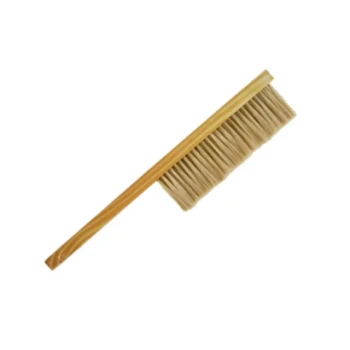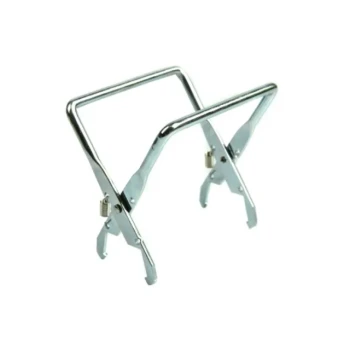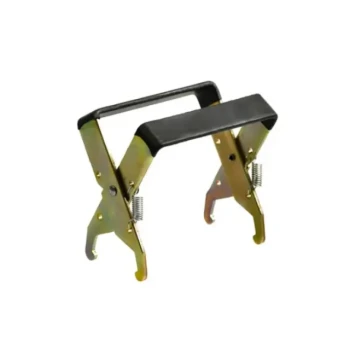To get bees to use plastic foundation, you must coat it with an additional, generous layer of melted beeswax. Bees are often slow to accept bare or thinly coated plastic because it is an unnatural material. Applying your own wax layer makes the surface far more attractive and encourages them to begin drawing comb.
While adding a coat of wax is the critical first step, true success with plastic foundation depends on a deeper principle: bees will only build comb, on any surface, when they have the abundant resources of a strong nectar flow.
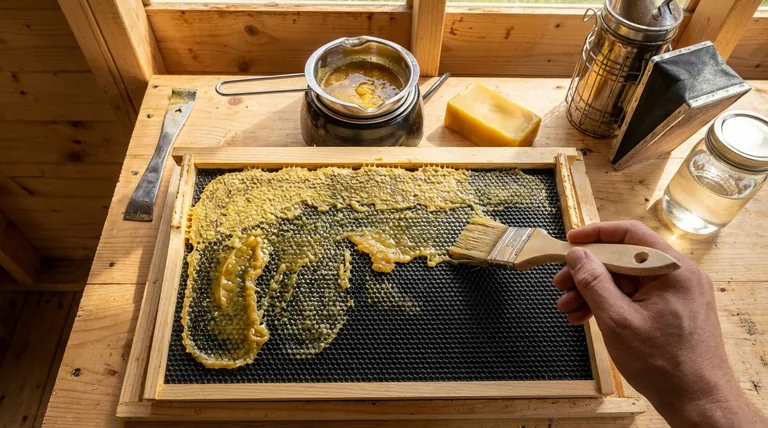
Why Bees Hesitate with Plastic Foundation
Understanding bee biology is the key to solving this common frustration. The reluctance is not arbitrary; it stems from their innate instincts for scent and material.
A Matter of Scent and Texture
Bees are creatures of wax. Their entire world of construction is built upon the scent, texture, and properties of beeswax they produce themselves.
Bare plastic is a foreign material that lacks the familiar scent and workable texture they instinctively seek. It is smooth, impermeable, and feels alien to them.
The Critical Role of a Wax Coating
A layer of beeswax acts as a bridge between the foreign plastic and the bees' natural instincts. Think of it as a primer that makes the surface acceptable for their work.
While most commercial plastic foundations come pre-waxed, this coating is often thin and inconsistent. Applying your own thick, even layer of melted beeswax provides the strong scent and texture needed to signal "this is a place to build."
Beyond the Foundation: The Principle of Resource Abundance
Even the most perfectly waxed frame will be ignored if the colony lacks the resources and motivation to expand. This is the most overlooked factor in getting comb drawn.
The Nectar Flow is Non-Negotiable
Drawing comb is an energy-intensive task. Bees must consume large amounts of nectar or honey to produce tiny flakes of wax from their bodies.
A strong nectar flow is the primary trigger for wax production. This influx of resources signals to the colony that it's time to expand, store surplus honey, and raise more brood. Without this signal, they will conserve energy and build nothing.
When to Stimulate with Feeding
If the natural nectar flow is weak or non-existent (a "dearth"), you must simulate one.
Feeding your bees a 1:1 sugar-to-water syrup provides the carbohydrate fuel they need to produce wax. This supplemental feeding can be the deciding factor that convinces a colony to start drawing out new foundation, whether it is plastic or wax.
Understanding the Trade-offs
Choosing plastic foundation is a decision with clear benefits and drawbacks. Being aware of them allows you to make an informed choice for your apiary.
Durability vs. Natural Material
Plastic foundation is extremely durable and rigid. It holds up to the high speeds of honey extractors, resists pest damage from wax moths, and can be scraped and reused for many years.
Traditional beeswax foundation is entirely natural but is far more fragile. It can easily break during extraction, especially on hot days, and is susceptible to damage in storage.
Convenience vs. Labor
Pre-waxed plastic foundation is often seen as a convenient, ready-to-use option. However, as noted, it often requires an extra step of adding more wax to ensure bee acceptance.
This creates a trade-off. You gain long-term durability and reusability, but you may need to invest the initial labor of waxing the frames yourself to get good results.
Making the Right Choice for Your Hive
Success hinges on aligning your equipment choice with the biological needs of the bees. Use this checklist to guide your strategy.
- If your primary focus is rapid hive expansion: Use heavily waxed plastic foundation and install it during a strong nectar flow or while actively feeding a 1:1 sugar syrup.
- If your primary focus is durability and long-term use: Plastic is the superior choice, but commit to waxing it properly to ensure the bees will accept and use it effectively.
- If your primary focus is maintaining an all-natural hive: Stick with pure beeswax foundation, but be prepared for the extra care required during handling and extraction.
Ultimately, understanding and providing what your bees need is the key to making any piece of equipment successful.
Summary Table:
| Key Factor | Why It Matters | Action Required |
|---|---|---|
| Wax Coating | Bare plastic lacks the natural scent and texture bees need. | Apply a generous, even layer of melted beeswax. |
| Nectar Flow | Bees need abundant resources to produce wax and build comb. | Install foundation during a strong flow or feed 1:1 sugar syrup. |
| Foundation Type | Plastic offers durability but requires more initial effort. | Choose based on your priorities: durability (plastic) vs. naturalness (beeswax). |
Ready to build a stronger, more productive apiary?
At HONESTBEE, we supply commercial apiaries and beekeeping equipment distributors with the durable, high-quality supplies needed for success. Whether you're expanding your operation or optimizing your equipment for maximum bee acceptance, our wholesale-focused team is here to support you.
Contact our experts today to discuss your needs for plastic foundation, wax, and other essential beekeeping supplies.
Visual Guide
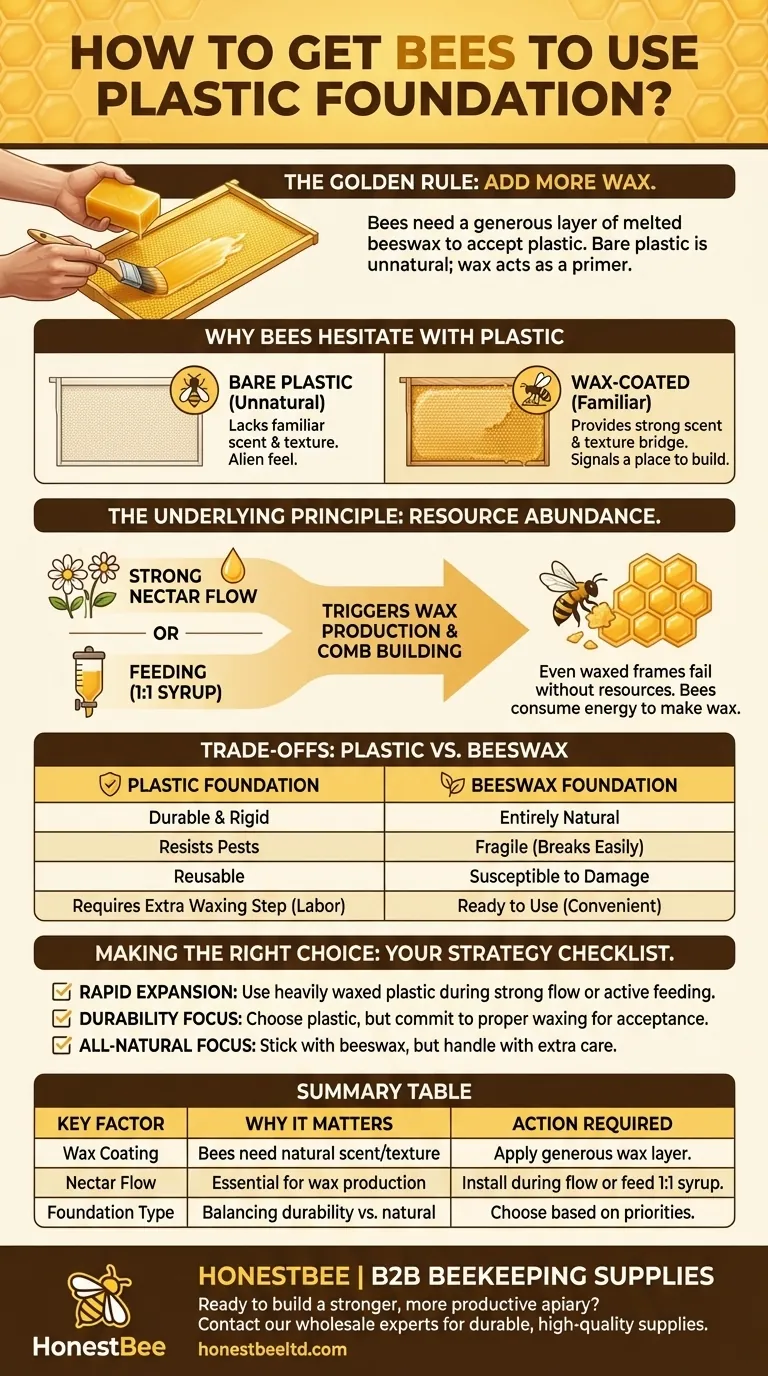
Related Products
- Food Grade Plastic bee Foundation for Bee Frames
- Notebook Style Beeswax Foundation Mould Wax Foundation Mold
- Manual Beeswax Comb Foundation Machine Wax Foundation Mill Embossing Machine
- Beeswax Foundation Sheets Beehive Foundation for Wholesale
- Professional Frame Preparation: The HONESTBEE Electric Wire Embedder
People Also Ask
- What is a plastic foundation sheet? A Durable, Reusable Hive Management Solution
- Why is it beneficial to coat plastic foundation with beeswax? Boost Hive Acceptance & Comb Building
- Does plastic foundation affect honey quality or taste? A Practical Guide for Beekeepers
- How does plastic foundation differ from beeswax foundation? Choose the Best for Your Hive's Success
- What additional step can improve the performance of plastic foundation in the hive? Apply a Generous Coat of Beeswax














